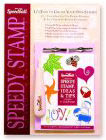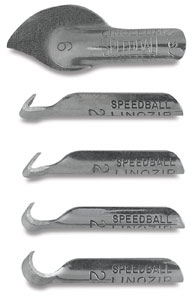| Tool Selection If someone made a power tool for carving stamps, I might buy it. Just because it's a power tool. I have a lot of tools. Many of them I've used once or twice, some just a few times, and others I use often enough to get them worn. Some I probably could have borrowed rather than buying, but the boyish excitement at the thought of extracting a shiny, clean, new toy from its packaging is something to which I must succumb every once in a while. But when it comes to carving stamps, there isn't a whole lot to choose from... What Do People Use?
Blades are sold in pairs, sets and in the larger carving sets that give you more than just blades. Blades range in size from #1 (the smallest) to #5 (the largest), and there's even a slicing-type blade for mega-rubber removal. And they come in that killer retro box (I hope!).
Staedler, the makers of MasterCarve, purportedly the best stamp carving material around, have their own brand of linoleum cutters. You buy these in a set with three different blade sizes permanently attached to a stylus. And therein lies my issue with them... permanently attached blades. You can find Linoleum Cutters locally at arts & crafts store and sometimes hobby stores. You can always buy them online, too. I recommend Dick Blick. How accurate your cuts are depends on the shape of the tip, which is why you should examine the cutting end before you buy your blades. I've found that if the cutting edges are nearly perpendicular to the bottom and top edges, you'll get the best results. The cutting edges should be as straight as possible, not wavy or unevenly sharpened. The twin edges should also be as symmetrical as possible. That might seem like a lot to ask for, but this is a precision instrument and you want to get the most precise one in the store. * X-Acto Knives, commonly known as hobby knives. You can find these just about anywhere. But consider the blade you're using. Is it the standard-issue #11 blade, the long, needlepoint-sharp one? You might want to consider the #16 blade. The blade angle is 45 degrees, which means you'll be able to cut faster without going very deep. I've found that they're easier to control on straight lines and still afford easy cornering. They're also excellent for the piercing excavation carving method. X-Acto also has a very tiny blade that swivels. I have not tried it because it swivels. Maybe I'm just being skeptical, but relinquishing even a tiny fraction of control to that blade when I'm finishing a 4-hour carving that's been perfect so far just doesn't sit well with me. The #16 blade can be purchased in a dispenser pack from online resources, and can be purchased in a blade set that includes one #16, two #11s, a flat-head blade and a big curved blade. The set can be found in many places where the knives are sold. There is also a real fancy set that has a mess of stuff in it. *Etcetera: boxcutters, utility knives, syringe needles (not kidding—they're usually those meant for farm animals), straight razors, double-edged razors (for those who live dangerously), paring knives, and genuine Victorinox Swiss Army knives (because nothing is sharper longer!). |
 *
*
 There are two handles to choose from: one fashioned of
plastic with a
metal business end chucked for easy nib swapping and a hollow handle for blade
storage, and one plain-Jane unfinished wooden handle with a machined business end. The
fancy handle is sold as part of a cutter kit and is sold separately. The rustic
handle is sold in the two Speedball
There are two handles to choose from: one fashioned of
plastic with a
metal business end chucked for easy nib swapping and a hollow handle for blade
storage, and one plain-Jane unfinished wooden handle with a machined business end. The
fancy handle is sold as part of a cutter kit and is sold separately. The rustic
handle is sold in the two Speedball
 The
shape of nibs also varies. Those most commonly available are V-shaped at the tip
and gracefully blend to a U shape at the stem. A new variety of cutters called
LinoZips are meant to be pulled sideways through the medium. I haven't tried
these, but they certainly look interesting... from this angle, it would appear
that you could more easily narrow the V on the "21" nib (second from the top, at
left) than you could on a standard #1 nib.
The
shape of nibs also varies. Those most commonly available are V-shaped at the tip
and gracefully blend to a U shape at the stem. A new variety of cutters called
LinoZips are meant to be pulled sideways through the medium. I haven't tried
these, but they certainly look interesting... from this angle, it would appear
that you could more easily narrow the V on the "21" nib (second from the top, at
left) than you could on a standard #1 nib.